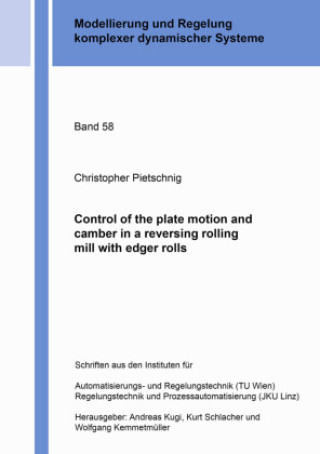
Kód: 42645437
Control of the plate motion and camber in a reversing rolling mill with edger rolls
Autor Christopher Pietschnig
In flat steel rolling, reversing hot rolling mills are typically used to reduce the thickness of steel slabs or plates. Some reversing rolling mills are equipped with edger rolls to adjust the width of the rolled plate. At best, t ... celý popis
- Jazyk:
 Angličtina
Angličtina - Vazba: Brožovaná
- Počet stran: 116
Nakladatelství: Shaker, 2023
- Více informací o knize

1102 Kč
Dostupnost:
50 % šance Máme informaci, že by titul mohl být dostupný. Na základě vaší objednávky se ho pokusíme do 6 týdnů zajistit.
Máme informaci, že by titul mohl být dostupný. Na základě vaší objednávky se ho pokusíme do 6 týdnů zajistit.Prohledáme celý svět
Mohlo by se vám také líbit
Dárkový poukaz: Radost zaručena
- Darujte poukaz v libovolné hodnotě a my se postaráme o zbytek.
- Poukaz se vztahuje na celou naši nabídku.
- Elektronický poukaz vytisknete z e-mailu a můžete ihned darovat.
- Platnost poukazu je 12 měsíců od data vystavení.
Informovat o naskladnění knihy
Zadejte do formuláře e-mailovou adresu a jakmile knihu naskladníme, zašleme vám o tom zprávu. Pohlídáme vše za vás.
Více informací o knize Control of the plate motion and camber in a reversing rolling mill with edger rolls
Nákupem získáte 110 bodů
 Anotace knihy
Anotace knihy
In flat steel rolling, reversing hot rolling mills are typically used to reduce the thickness of steel slabs or plates. Some reversing rolling mills are equipped with edger rolls to adjust the width of the rolled plate. At best, the plate passes the roll gap laterally centered and has a perfect cuboid shape with defined geometries. In reality, lateral nonuniformities like temperature gradients and thickness inhomogeneities cause the plate to drift in a lateral direction. This can result in a camber or thickness wedge or both. These effects deteriorate the product quality and can also entail collisions with the mill stand or other equipment along the roller table. To prevent such problems, active control of the lateral position and contour shape is indispensable.In this work, a reversing roughing mill of voestalpine Stahl GmbH, Linz, Austria is considered. The roll gap adjustment works electromechanically and self-retaining, meaning that it can only be adjusted between two consecutive rolling passes. The industrial plant is further equipped with edger rolls, originally intended to counteract spreading in forward rolling passes. This work, is dedicated to the question if these edger rolls are also suitable as an alternative control input to control the lateral position and centerline shape of the plate during the rolling passes by moving them in a lateral direction.
 Parametry knihy
Parametry knihy
1102 Kč
- Plný název: Control of the plate motion and camber in a reversing rolling mill with edger rolls
- Autor: Christopher Pietschnig
- Jazyk:
 Angličtina
Angličtina - Vazba: Brožovaná
- Počet stran: 116
- EAN: 9783844089004
- ID: 42645437
- Nakladatelství: Shaker
- Hmotnost: 170 g
- Rozměry: 210 × 148 mm
- Rok vydání: 2023
Oblíbené z jiného soudku
-

Berserk Deluxe Volume 1
1033 Kč -

Haunting Adeline
617 Kč -

Berserk Deluxe Volume 2
1033 Kč -

Berserk Deluxe Volume 3
1138 Kč -

Atomic Habits
340 Kč -

Cry Baby Coloring Book
270 Kč -

House of Leaves
541 Kč -

Powerless
225 Kč -

Harry Potter and the Prisoner of Azkaban (Minalima Edition)
978 Kč -

The Official Stardew Valley Cookbook
607 Kč -

Chainsaw Man, Vol. 15
257 Kč -

Iron Flame
353 Kč -

Hunting Adeline
633 Kč -

Berserk Deluxe Volume 5
1115 Kč -

JUJUTSU KAISEN V22
257 Kč -

White Nights
90 Kč -

Gravity Falls Journal 3
462 Kč -

Berserk Deluxe Volume 4
1165 Kč -

Bungo Stray Dogs, Vol. 8 (light novel)
387 Kč -

Berserk Deluxe Volume 6
1086 Kč -

Twisted Love
215 Kč -

Surrounded by Idiots
256 Kč -

The 48 Laws of Power
523 Kč -

Twisted Games
276 Kč -

Twisted Lies
276 Kč -

Fourth Wing
214 Kč -

Heaven Official's Blessing: Tian Guan Ci Fu (Novel) Vol. 2
442 Kč -

Dune Messiah
178 Kč -

Court of Thorns and Roses Paperback Box Set (5 books)
1322 Kč -

A Little Life
258 Kč -

Heaven Official's Blessing: Tian Guan Ci Fu (Novel) Vol. 1
428 Kč -

CHAINSAW MAN V14
217 Kč -

Dune
254 Kč -

Dungeons & Dragons Essentials Kit (D&d Boxed Set)
626 Kč -

No Longer Human
259 Kč -

Berserk Deluxe Volume 10
1163 Kč -

Court of Thorns and Roses
218 Kč -

Court of Mist and Fury
221 Kč -

Harry Potter and the Chamber of Secrets: MinaLima Edition
835 Kč -

King of Sloth
276 Kč -

Raising Mentally Strong Kids: How to Combine the Power of Neuroscience with Love and Logic to Grow Confident, Kind, Responsible, and Resilient Child
593 Kč -

Heaven Official's Blessing: Tian Guan Ci Fu Vol. 4
441 Kč -

Icebreaker
254 Kč -

Berserk Deluxe Volume 7
1110 Kč -

The Husky and His White Cat Shizun: Erha He Ta de Bai Mao Shizun (Novel) Vol. 5
372 Kč -

Vagabond (VIZBIG Edition), Vol. 1
513 Kč -

48 Laws Of Power
372 Kč -

Berserk Deluxe Volume 11
1102 Kč -

Twisted Series 4-Book Boxed Set
1078 Kč
Osobní odběr Praha, Brno a 12903 dalších
Copyright ©2008-24 nejlevnejsi-knihy.cz Všechna práva vyhrazenaSoukromíCookies





 Vrácení do měsíce
Vrácení do měsíce 571 999 099 (8-15.30h)
571 999 099 (8-15.30h)